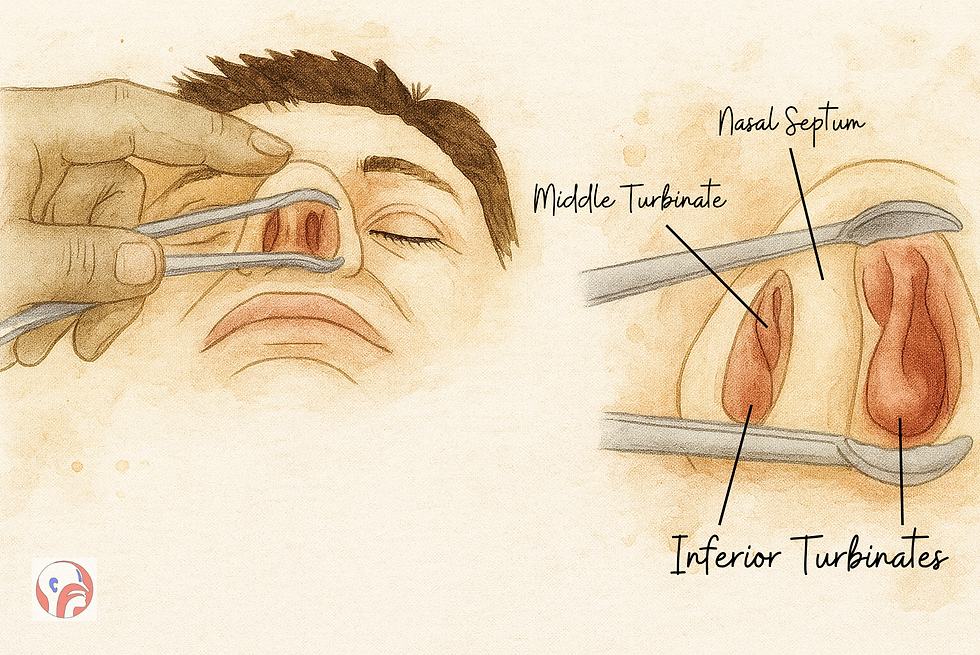top of page

Turbinate Hypertrophy Treatment by ENT Specialist in Johor, Malaysia
What Are Turbinates?
Inside your nose, there are three pairs of soft bony structures called turbinates — inferior, middle, and superior turbinates.
They help warm, filter, and humidify the air you breathe. Each turbinate is covered with a layer of tissue rich in blood vessels that can swell or shrink depending on the environment.
What Does “Enlarged Turbinates” Mean?
When these turbinates stay swollen for a long period, they block airflow and cause chronic nasal blockage.
This condition is called turbinate hypertrophy or enlarged turbinates.
In Malay, it’s often described as hidung tersumbat akibat turbinat bengkak.

The image shows a nasal speculum examination where the clinician gently opens the nostril to visualize the nasal cavity. Inside, the normal inferior and middle turbinates are clearly seen along the nasal wall.
Common Causes of Turbinate Swelling
-
Allergic rhinitis (resdung / alahan hidung)
🔗 Learn more: Allergic Rhinitis and Sinus Allergy
-
Chronic sinusitis
-
Deviated nasal septum (hidung senget / septum bengkok)
🔗 Related treatment: Septoplasty – Correcting a Deviated Septum
-
Environmental irritants (dust, smoke, perfume, haze)
-
Long-term use of nasal decongestant sprays, e.g Oxymetazoline sprays.
-
Hormonal changes (pregnancy, thyroid disorders)
Symptoms of Enlarged Turbinates
Patients often describe:-
-
Persistent nasal congestion, often one-sided
-
Snoring or mouth breathing, especially at night
-
Reduced smell (hyposmia)
-
Headache or facial pressure
-
Blocked nose even after blowing
If these symptoms persist for weeks or months, an ENT evaluation is recommended.
How Is It Diagnosed?
At Dr Cheong Ear Nose and Throat (ENT), Sinus, Head & Neck Clinic – KPJ Pasir Gudang Specialist Hospital, assessment includes:
-
Detailed ENT consultation and examination
-
Nasal endoscopy (nasoendoscopy) to directly view swollen turbinates
-
CT scan of sinuses if structural or sinus disease is suspected
🩺 These steps help differentiate whether blockage is due to turbinate hypertrophy, sinusitis, or septal deviation.
Treatment Options for Enlarged Turbinates
1. Medical Treatment
Most mild to moderate cases respond well to:
-
Allergy control and trigger avoidance
-
Nasal steroid sprays (reduce mucosal swelling)
-
Saline nasal rinse
-
Oral antihistamines or short courses of decongestants
🔗 Learn more about Sinus Rinse & Nasal Care
2. Minimally Invasive Procedures
If medical treatment fails, procedures may be performed under general anaesthesia:
-
Radiofrequency turbinate reduction (RFT)
Shrinks turbinate tissue using controlled heat energy. -
Endoscopic turbinoplasty
Reshapes the turbinate under direct vision while preserving its normal function.
These are commonly performed together with septoplasty when septal deviation is present.
⚕️ Combined Septoplasty + Turbinoplasty helps improve nasal breathing and long-term results.
bottom of page



